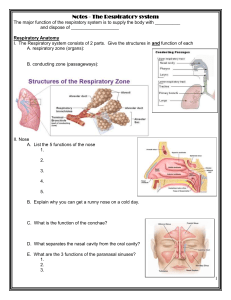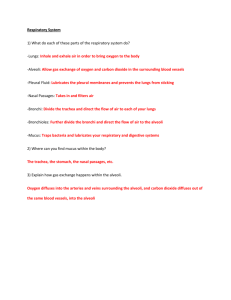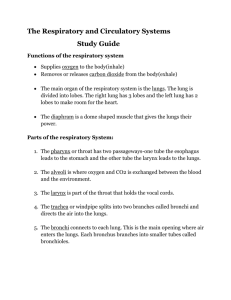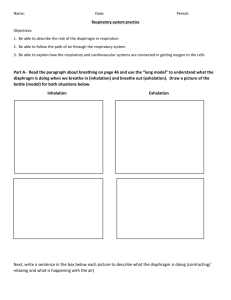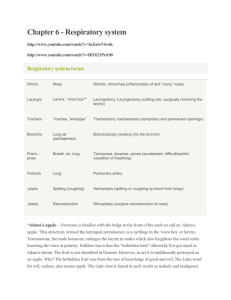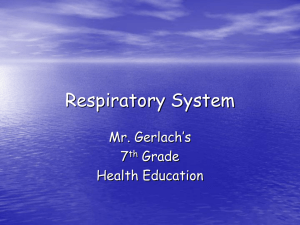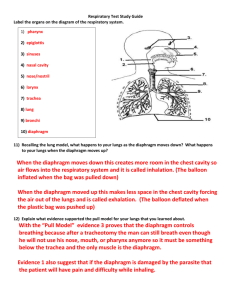Respiratory Test and Vocabulary Words
advertisement
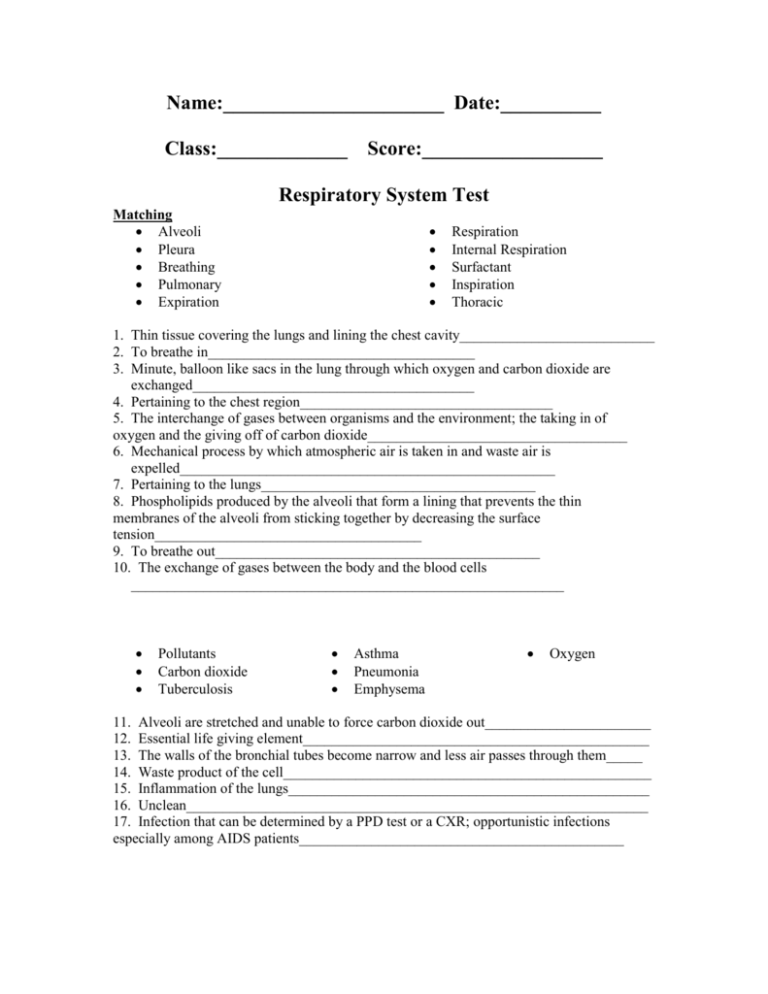
Name:______________________ Date:__________ Class:_____________ Score:__________________ Respiratory System Test Matching Alveoli Pleura Breathing Pulmonary Expiration Respiration Internal Respiration Surfactant Inspiration Thoracic 1. Thin tissue covering the lungs and lining the chest cavity___________________________ 2. To breathe in_____________________________________ 3. Minute, balloon like sacs in the lung through which oxygen and carbon dioxide are exchanged_______________________________________ 4. Pertaining to the chest region___________________________________ 5. The interchange of gases between organisms and the environment; the taking in of oxygen and the giving off of carbon dioxide____________________________________ 6. Mechanical process by which atmospheric air is taken in and waste air is expelled____________________________________________________ 7. Pertaining to the lungs______________________________________ 8. Phospholipids produced by the alveoli that form a lining that prevents the thin membranes of the alveoli from sticking together by decreasing the surface tension_____________________________________ 9. To breathe out_____________________________________________ 10. The exchange of gases between the body and the blood cells ____________________________________________________________ Pollutants Carbon dioxide Tuberculosis Asthma Pneumonia Emphysema Oxygen 11. Alveoli are stretched and unable to force carbon dioxide out_______________________ 12. Essential life giving element________________________________________________ 13. The walls of the bronchial tubes become narrow and less air passes through them_____ 14. Waste product of the cell___________________________________________________ 15. Inflammation of the lungs__________________________________________________ 16. Unclean________________________________________________________________ 17. Infection that can be determined by a PPD test or a CXR; opportunistic infections especially among AIDS patients_____________________________________________ Multiple Choice 18. The special piece of cartilage that closes the opening of the larynx during swallowing is called o a.epiglottis o b.epistaxis o c.thyroid cartilage o d.glottis 19. The pouch containing a cordlike framework that creates voice sounds is called o a.pharynx o b.oral cavity o c.larynx o d.trachea 20. The hair like objects that help move mucus, dust, and pathogens up and out of the lungs are called o a.ronchi o b.cilia o c.glottis o d.conchae 21. The muscular wall that divides the chest cavity from the abdominal cavity is called the o a.intercostals o b.myocardium o c.deltoid o d.diaphragm 22. External respiration occurs in the o a.cells of the body o b.in the left atrium o c.in the alveoli o d.in the nose 23. Internal respiration occurs in the o a.cells of the body o b.in the left atrium o c.in the alveoli o d.in the nose 24. The turbinates (conchae) that increase the surface area of the nasal cavity aide in doing all of the following EXCEPT o a.warm the air o b.moisten the air o c.filter the air o d.add nutrients 25. The following are the 4 paranasal sinuses o a.occipital, ethmoid, sphenoid, maxillary o b.frontal, ethmoid, sphenoid, maxillary o c.parietal, maxillary, occipital, ethmoid o d.frontal, occipital, sphenoid, mastoid 26. The sinuses give resonance to our voices and lightness to our heads. o a.True o b.False 27. The nasolacrimal ducts transport chyme to our Eustachian tube. o a.True o b.False 28. The tears contain lysozyme which when conveyed into our nasal cavities fights bacterial and viral invasion. o a.True o b.False 29. The Eustachian tube is located between the middle ear and the pharynx to help equalize pressure on both sides of the eardrum. o a.True o b.False 30. The Hering-Breuer reflex makes a person withdraw their hand when heat is applied. o a.True o b.False 31. Anatomical dead space is that area of the respiratory tree in which the air is never used; the air is inhaled and exhaled and never reaches the alveoli. o a.True o b.False 32. Sputum specimens are obtained for the following reasons: o a.to cleanse the nose and lungs of excess mucus o b.to culture the causative agent for a respiratory infection o c.to look for cancerous cells from the lungs o d.both b and c 33. The non-respiratory movement characterized by sudden inspiration, resulting from spasms of the diaphragm is called a/an: o a.epistaxis o b.sneeze o c.cough o d.hiccup 34. The nonrespiratory movement where a deep breath is taken, the glottis is closed, and air is forced out of the lungs against the glottis (used to clear the lower respiratory passageways) is called a/an: o a.epistaxis o b.sneeze o c.cough o d.hiccup 35. The non-respiratory movement that clears the upper respiratory passageways is called a/an: o a.epistaxis o b.sneeze o c.cough o d.hiccup Matching. Each term will be used only once. (Use abbreviations, if appropriate) o Dead space volume o Expiratory reserve volume (ERV) o Inspiratory reserve volume (IRV) o Residual volume (RV) o Tidal volume (TV) o Total lung capacity (TLC) o Vital capacity (VC) 36. 37. 38. 39. 40. Respiratory volume inhaled or exhaled during normal breathing_______________________ Total amount of exchangeable air_____________________________________ Gas volume that allows gas exchange to go on continuously__________________________ Amount of air that can still be exhaled (forcibly) after a normal exhalation_______________ Sum of all lung volumes__________________________________ Matching. The following terms may be used once, more than once, or not at all. o Apnea o Sleep apnea o Hypoxia o Emphysema o Chronic bronchitis o Cheyne-Stokes o Lung cancer o Eupnea o Dyspnea o Rales 41. Lack or cessation of breathing__________________________________________________ 42. Normal breathing in terms of rate and depth_______________________________________ 43. Labored breathing, or “air hunger” ______________________________________________ 44. Chronic oxygen deficiency_____________________________________________________ 45. Respirations gradually increase in rate then cease entirely for a few seconds ______________________________________________________________ 46. Condition characterized by fibrosis of the lungs and an increase in size of the alveolar chambers______________________________________________________________________ 47. Condition characterized by increased mucus production that clogs respiratory passageways and promotes coughing________________________________________________ 48. Together called COPD________________________________________________________ 49. Incidence strongly associated with cigarette smoking; has increased dramatically in women recently________________________________________________________________ 50. Victims become barrel-chested because of air retention______________________________ 51. Temporary cessation of breathing during sleep ____________________________________ Matching. Each term may be used once or not at all. o Bronchioles o Palate o Epiglottis o Trachea o Esophagus o Uvula o Glottis 52. 53. 54. 55. 56. 57. Narrowest portion of the respiratory tree__________________________________________ Smallest respiratory passageways_______________________________________________ Closes the nasopharynx during swallowing________________________________________ Separates the oral and nasal cavities_____________________________________________ Windpipe__________________________________________________________________ Food passageway posterior to the trachea_________________________________________ Respiratory Diseases and Disorders 1. nasopharyngitis: inflammation of the nose and pharynx 2. cystic fibrosis: hereditary children’s disorder with increased abnormal mucus production 3. parasinusitis: inflammation of all of the sinuses 4. acute coryza: common cold; most widespread of all communicable diseases; characterized by swollen and inflamed mucous membrane of the nose and throat 5. tuberculosis: primarily a lung disorder caused by the tubercle bacillus, Mycobacterium tuberculosis; extremely contagious 6. atelectasis: collapsed lung 7. pneumonitis: inflammation of the lung 8. thoracalgia: pain in the chest 9. rhinorrhea: runny nose 10. pleuritis: inflammation of the pleura 11. epistaxis: nose bleed; may result from injury, local infections, or drying out of the mucous membrane 12. influenza: the flu 13. pertussis: whooping cough 14. dysphonia: difficulty in speaking 15. orthopnea: breather only in an upright position 16. pneumonia: severe infection of the lungs 17. pleurisy: irritation of pleura, increased amount of pleural fluid; inflammation of the pleura or lining of the lungs and chest cavity; the resulting swelling causes the linings to rub, causing friction and pain 18. empyema: pus in the chest (pleural space) 19. aphonia: absence of voice 20. asthma: chronic respiratory disease, coughing, wheezing due to constricted airways; shortness of breath with wheezing caused by obstruction of the flow of air in small bronchi or bronchioles due to swelling or spasm of the bronchial tubes or their mucous membranes 21. anoxia: deficiency of oxygen 22. croup: occurs in children; acute obstruction of the larynx 23. URI: inflammation of the nose, larynx, bronchus, upper respiratory infection 24. cough: mechanism for clearing obstruction from the airway 25. rhinomycosis: fungal infection of the nose 26. pharyngismus: muscular spasm of the pharynx 27. nasogastric tube (NG tube): tube inserted through the nostril into the stomach 28. rhinoplasty: plastic surgery of the nose 29. nasolabial: pertaining to the nose and lip 30. rhinorrhea: free discharge of thin nasal mucus 31. tachypnea: very rapid respirations 32. bradypnea: abnormal slowness of respiration 33. orthopnea: ability to breathe easily only in upright position

